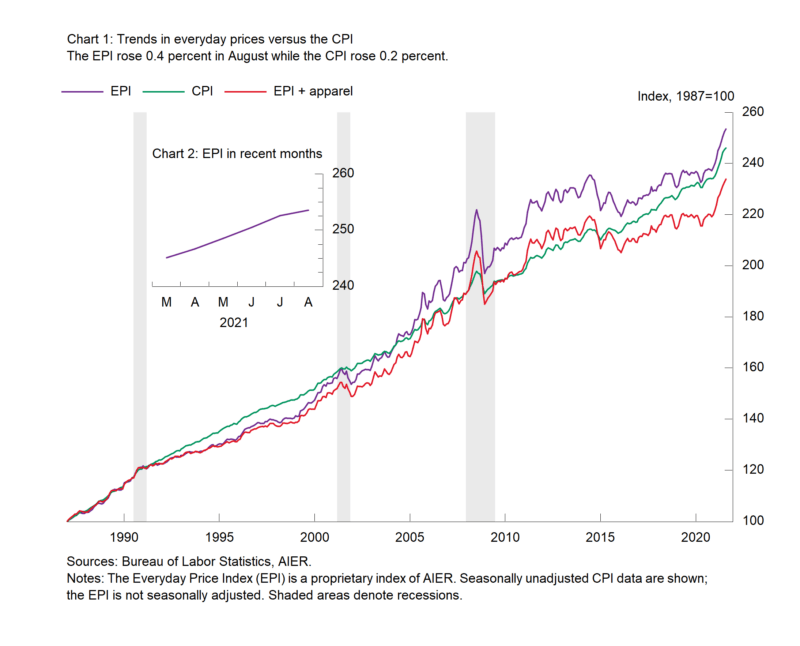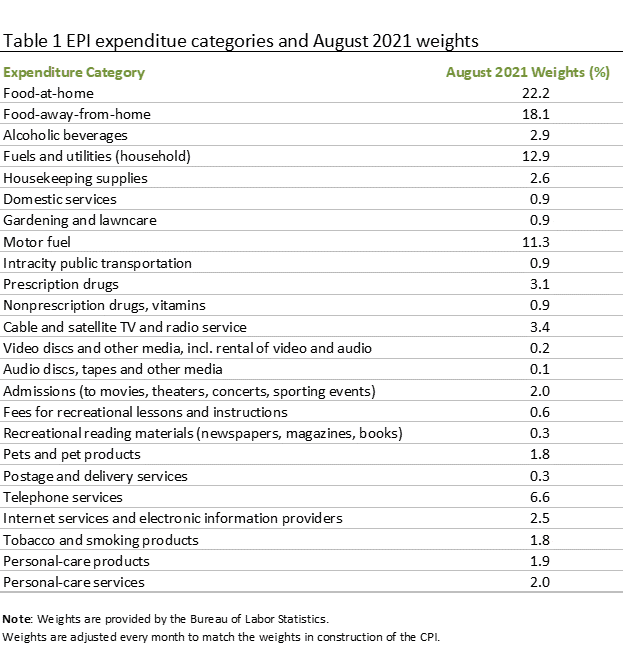Everyday Price Index Rises at a Slower Pace in August
The AIER Everyday Price Index increased by 0.4 percent in August, half the pace of the 0.8 percent gain in each of the prior three months and the first month with less than a 0.5 percent rise since November 2020. The most recent rise puts the 12-month gain at 6.8 percent, the fifth month in a row above 6 percent and the fastest pace since September 2011.
The positive contributors were again widespread in August outnumbering negative contributors three to one. Positive contributors were led by increases in food and energy categories. The largest contributors to the August increase in the Everyday Price Index were household fuels and utilities, up 0.8 percent for the month and contributing 10 basis points, food away from home (a.k.a. restaurants), up 0.4 percent for the month and contributing 8 basis points, motor fuels prices, up 0.7 percent and contributing 7 basis points, and food at home (a.k.a. groceries), up 0.3 percent and also adding 7 basis points.
Small negative contributors include intracity transportation (-1 basis point), housekeeping supplies (-1 basis point), and nonprescription drugs (-1 basis point).
The Everyday Price Index including apparel, a broader measure that includes clothing and shoes, rose 0.5 percent following three consecutive 0.7 percent monthly gains. Over the past year, the Everyday Price Index including apparel is up 6.6 percent, the fourth month in a row above 6 percent. Apparel prices jumped 1.8 percent on a not-seasonally-adjusted basis in August. Apparel prices tend to be volatile on a month-to-month basis, posting six increases and six decreases ranging from -2.2 percent to 2.9 percent over the last 12 months. From a year ago, apparel prices are up 4.2 percent.
The Consumer Price Index, which includes everyday purchases as well as infrequently purchased, big-ticket items and contractually fixed items, rose 0.2 percent on a not-seasonally-adjusted basis in August. Over the past year, the Consumer Price Index is up 5.3 percent versus 5.4 percent for the 12 months ending July.
The Consumer Price Index excluding food and energy rose 0.1 percent for the month (not seasonally adjusted) while the 12-month change came in at 4.0 percent, down from 4.3 percent in July. The 12-month change in the core CPI was just 1.3 percent in February.
After seasonal adjustment, the CPI rose 0.3 percent in August while the core increased 0.1 percent for the month. Within the core, core goods prices were up 0.3 percent in August and are up 7.7 percent from a year ago while core services prices were unchanged for the month but are up 2.7 percent from a year ago.
Among the notable increases in the core goods category were new vehicles (up 1.2 percent in August and 7.6 percent from a year ago), household furnishings and supplies (up 1.2 percent for the month and 3.3 percent from a year ago), televisions (up 2.8 percent for the month and 13.3 percent from a year ago), and sporting goods (up 2.3 percent for the month and 7.6 percent from a year ago).
Used car and truck prices fell 1.5 percent for the month but have increased 31.9 percent over the past year. Used cars and trucks prices had been one of the goods that have seen prices surge during the pandemic.
Among core services, gainers include household operations (up 0.7 percent and 7.3 percent from a year ago), and hospital services (up 0.8 percent and 3.7 percent from a year ago), while decliners include lodging away from home including hotels and motels (down 3.3 percent in August), health insurance (off 0.6 percent), motor vehicle insurance (-2.8 percent), and airline fares (-9.1 percent).
Prices for many goods and services in the economy continue to be distorted by lingering effects from government restrictions on consumers and businesses including shortages, logistical and supply chain issues, and labor problems. As activity returns to normal, supply and demand will adapt and likely lead to slower price increases, but it may take some time before the economy completely returns to normal functioning. Nevertheless, a 1970s-style upward price spiral remains unlikely.
Note: The Everyday Price Index for July is based on incomplete data due to restrictions on data collection by Bureau of Labor Statistics personnel because of the Covid-19 pandemic.







